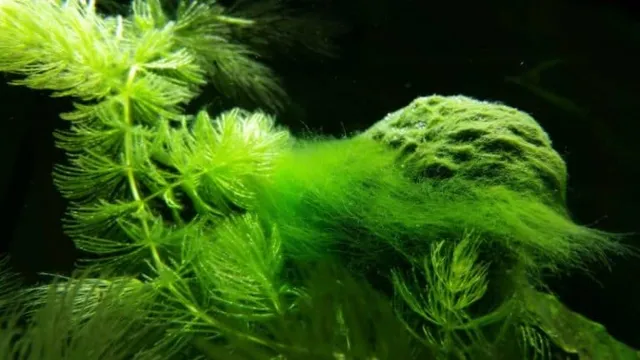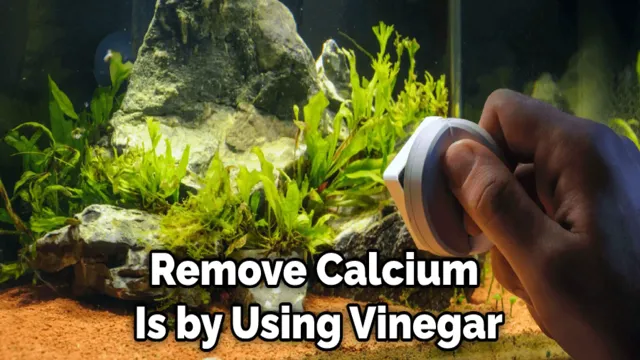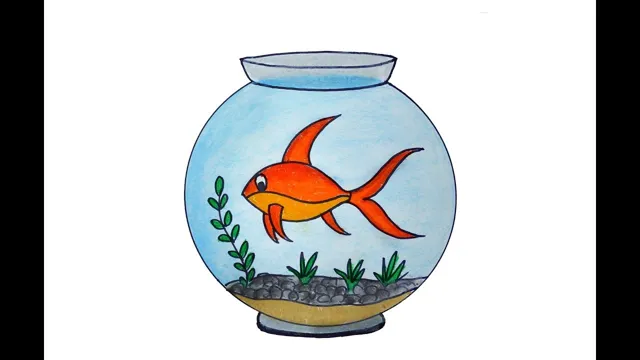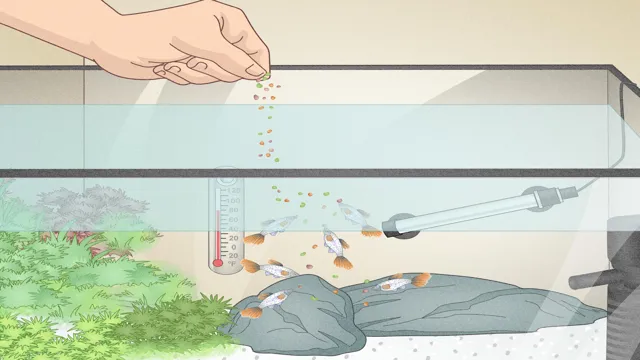Do you have stubborn black algae growing in your aquarium? It can be frustrating to see this pesky growth take over your pristine tank. Black hair algae, also known as BBA, is a common problem among aquarium owners. The good news is, with the right approach, it can be removed and prevented from coming back.
First off, let’s talk about what causes black hair algae. Typically it occurs in aquariums with excess nutrients and low CO2 levels. If your lighting is too strong or irregular, it can also contribute to BBA growth.
It’s important to address the root cause of the issue to effectively tackle the problem. One way to get rid of black hair algae is to physically remove it from your aquarium. This can be done through manual scrubbing or using a toothbrush.
Be sure to also do frequent water changes to reduce excess nutrients in the water. Another effective method is introducing Siamese algae eaters or Amano shrimp into your aquarium. These fish and crustaceans are natural predators of black hair algae and can help keep it at bay.
Preventing black hair algae from growing in the first place is key. Monitor your nutrient levels and ensure proper CO2 levels in your tank. Consider using a timer for your lighting to regulate the amount of light your aquarium is receiving.
Lastly, be sure to regularly maintain and clean your aquarium to keep it in top shape. With these tips and tricks, you can effectively kill and prevent black hair algae from taking over your aquarium. Say goodbye to unsightly growth and hello to a healthy and beautiful aquarium.
Identifying Black Hair Algae
Black hair algae can be a nuisance to aquarium owners. It’s easily identified by its hair-like appearance and dark color. It can take over your tank and suffocate your beloved plants if left untreated.
So how do we get rid of it? First, it’s essential to understand what causes black hair algae growth. It often occurs when there is an excess of nutrients, specifically phosphates, and inadequate carbon dioxide levels in the water. To eliminate black hair algae, you need to reduce phosphate levels by conducting frequent water changes and utilizing phosphate removers.
Adding carbon dioxide will also help reduce its growth. In severe cases, manually removing the algae is crucial. Be sure to do this carefully, as the algae can easily spread to other parts of the tank.
With persistent maintenance and proper care, black hair algae can be eradicated from your aquarium for good.
Appearance and Growth Habits
Black hair algae, also known as black brush algae, is a type of aquatic plant that can be a real headache for aquarium owners. This type of algae is easy to recognize as it forms a thick black mat on aquarium surfaces, and unlike other types of algae, it has a wire-like appearance. It can be quite difficult to get rid of as it is resistant to many common chemical treatments.
The best way to remove black hair algae is by physically removing it from the affected surfaces. Black hair algae tends to thrive in aquariums with high light levels and low CO2 levels, so ensuring that your aquarium environment is balanced can help prevent its growth. Additionally, adding some algae-eating fish to your aquarium – such as Siamese algae eaters or bristlenose plecos – can also help keep black hair algae at bay. (See Also: How to Clean Decorations in Aquarium: Tips and Tricks for Spotless Aquarium Decor)

Causes of Black Hair Algae Growth
Black hair algae can be a problem for aquarium owners, but the first step in dealing with it is identifying what it is. This type of algae is often mistaken for beard algae, but it has a much darker color and a stringy texture that looks like hair. It’s also notoriously difficult to get rid of, which is why it’s important to address it as soon as possible.
Black hair algae is caused by a number of factors, including high nutrient levels in the water, low CO2 levels, inconsistent lighting, and poor water circulation. Aquarium owners can take steps to prevent its growth, such as regularly cleaning their tanks and keeping a close eye on nutrient levels, but if it does appear, there are treatments available. Using an algae scraper or adding an algaecide to the water can be effective, but it’s important to address the underlying causes of the algae growth to prevent it from coming back.
Preventative Measures to Control Black Hair Algae
Black hair algae, also known as BHA, can be a real menace in any aquarium. This type of algae thrives on low light and high nutrient environments, and if not treated promptly, it can quickly spread and take over the tank. Fortunately, with the right preventative measures, you can control and eliminate black hair algae from your aquarium.
One way to do this is by ensuring good water circulation, as stagnant water can provide an excellent breeding ground for algae. You can also reduce the amount of light your aquarium receives by shortening the amount of time your aquarium lights are on. Additionally, ensure that your aquarium’s filtration system is functioning correctly and that you are not overfeeding your fish as excess food can contribute to the growth of BHA.
If you already have black hair algae in your aquarium, consider removing any infected plants or decor and performing a thorough cleaning. With persistence and the right techniques, you can successfully kill black hair algae in your aquarium and keep it at bay.
Keep Your Tank Clean
If you’re an aquarium owner, black hair algae is never a welcomed sight. It can be tough to control once it takes over your tank, leading to frustration and tank maintenance struggles. However, there are preventative measures you can take to keep black hair algae at bay.
First and foremost, keeping your tank clean is crucial. Ensuring your substrate, filter media, and decor are free of excess debris will prevent the algae from taking hold. Additionally, providing appropriate lighting and carbon dioxide levels can inhibit its growth.
Finally, introducing algae-eating fish, such as Siamese algae eaters or otocinclus catfish, can assist in keeping the algae at bay. By taking these preventative measures, you can keep your tank healthy and beautiful.
Maintain Proper Water Flow and Lighting
When it comes to preventing black hair algae in your aquarium, maintaining proper water flow and lighting is crucial. This type of algae thrives in stagnant water and low lighting conditions, making it important to ensure that water is circulating properly and not just sitting in one place. Additionally, it’s important to make sure the lighting in your aquarium is adequate for the type of plants and fish you have.
Too little light can encourage the growth of black hair algae, while too much can promote the growth of other types of algae. By finding the right balance and ensuring proper water flow and lighting, you can help prevent the growth of black hair algae in your aquarium and maintain a healthy environment for your aquatic pets.
Monitor Your Nutrient Levels
One of the most effective preventative measures for controlling black hair algae in your aquarium is to regularly monitor your nutrient levels. Algae thrive in environments where the nutrient levels are high, particularly when it comes to phosphates and nitrates. Therefore, it’s important to monitor your water parameters and ensure that they remain within the acceptable range for your fish and plants. (See Also: How to Build a 3D Aquarium Background: Step-by-Step Guide for Stunning Aquatic Display)
This can be achieved through regular water changes, adding live plants to your aquarium, and using high-quality filtration equipment. By keeping a close eye on your nutrient levels, you can prevent the growth of black hair algae and ensure that your aquarium remains healthy and vibrant. So, make sure to test your water regularly and take steps to correct any imbalances in your nutrient levels before they have a chance to take hold.
How to Eliminate Black Hair Algae
If you’re an aquarium owner, you might have noticed that black hair algae can be a pesky problem to deal with. But don’t worry, there are ways to eliminate this type of algae from your aquarium! First, it’s important to understand black hair algae is caused by a variety of factors, including low CO2, low phosphates, high light levels, and low water flow. To combat this, make sure your aquarium has healthy water parameters and a quality filtration system.
Additionally, you can add algae-eating fish, such as Siamese algae eaters, to your tank to help control the growth. You can also scrub the algae with a toothbrush and use chemical treatments specifically designed for black hair algae. Overall, with consistent maintenance and proper care, it is possible to eliminate black hair algae from your aquarium.
So don’t give up, keep your aquarium healthy and clean!
Physical Removal
Black Hair Algae If you’re struggling with persistent Black Hair Algae in your aquarium, physical removal is one of the most effective methods of getting rid of it. This involves manually scrubbing and removing the algae from any surfaces it has attached to. A non-abrasive scrubber or brush can be used, and the process should be thorough to ensure all traces are eliminated.
Black Hair Algae can attach itself to a variety of surfaces, so make sure to check and clean everything in your aquarium including rocks, plants, and decorations. It’s also important to maintain good water quality and reduce excess nutrients as these can contribute to the growth of Black Hair Algae. Consistent maintenance and attention to detail are key to eradicating this persistent algae problem.
Chemical Treatment
One of the most stubborn types of algae that can grow in aquariums is black hair algae. It’s a type of algae that can attach itself to almost anything, including plants, rocks, and even the glass of your aquarium. To eliminate black hair algae, you need to take some chemical treatments.
There are different types of chemicals that can be used, including hydrogen peroxide, potassium permanganate, and algaecides. These chemicals can be used with caution as they may harm the other organisms in your aquarium. Hydrogen peroxide and potassium permanganate are highly effective but require careful dosing to avoid harming the fish or their home.
Algaecides, on the other hand, should only be used as a last resort, as they can harm the entire ecosystem of your aquarium. Regular maintenance and water changes can help prevent black hair algae from forming and spreading in the future. So, if you notice black hair algae in your aquarium, take action right away, and use the appropriate chemical treatment to eliminate it safely and effectively.
Conclusion
In conclusion, black hair algae is a pesky problem that can wreak havoc on any aquarium. But fear not, intrepid aquarist! With the right approach, you can eliminate and prevent this frustrating algae for good. From modifying lighting and nutrient levels to introducing algae-eating livestock, the key is to attack black hair algae from multiple angles. (See Also: How to Make Your Own Aquarium Coffee Table: Step-by-Step Guide)
So roll up your sleeves, dive in, and show that algae who’s boss! After all, when it comes to keeping your aquarium in pristine condition, there’s no such thing as a hairy situation you can’t handle.”
FAQs
What is black hair algae in an aquarium?
Black hair algae, also known as brush algae, is a type of stubborn and unsightly algae that grows in aquariums. It can quickly take over the aquarium and harm the fish and plants.
How does black hair algae form in an aquarium?
Black hair algae forms when there is an excess of nutrients, light, and carbon dioxide in the aquarium. It can also form due to poor water quality.
Can black hair algae harm fish in the aquarium?
Yes, black hair algae can harm fish by reducing the oxygen levels in the water and causing stress to fish. It can also cover the fish’s gills, making it difficult for the fish to breathe.
What are the best ways to prevent black hair algae in an aquarium?
To prevent black hair algae from forming, you should ensure proper aquarium maintenance, including regular water changes and cleaning. You should also avoid overfeeding and overstocking the aquarium.
Can black hair algae be removed manually from the aquarium?
Yes, black hair algae can be removed manually by using a brush or scraper to loosen it and then removing it with a net or siphon. However, it is important to ensure that the algae has not spread too much before manually removing it.
Are there any chemical treatments available to get rid of black hair algae in an aquarium?
Yes, there are several chemical treatments available for getting rid of black hair algae in an aquarium, including algae-eating fish, hydrogen peroxide, and algaecides. However, it is important to use these treatments carefully and according to the instructions.
How long does it take to completely get rid of black hair algae from an aquarium?
The time it takes to completely get rid of black hair algae from an aquarium can vary depending on the severity of the algae growth and the methods used to remove it. It may take a few weeks to a few months to completely remove the algae from the aquarium.







